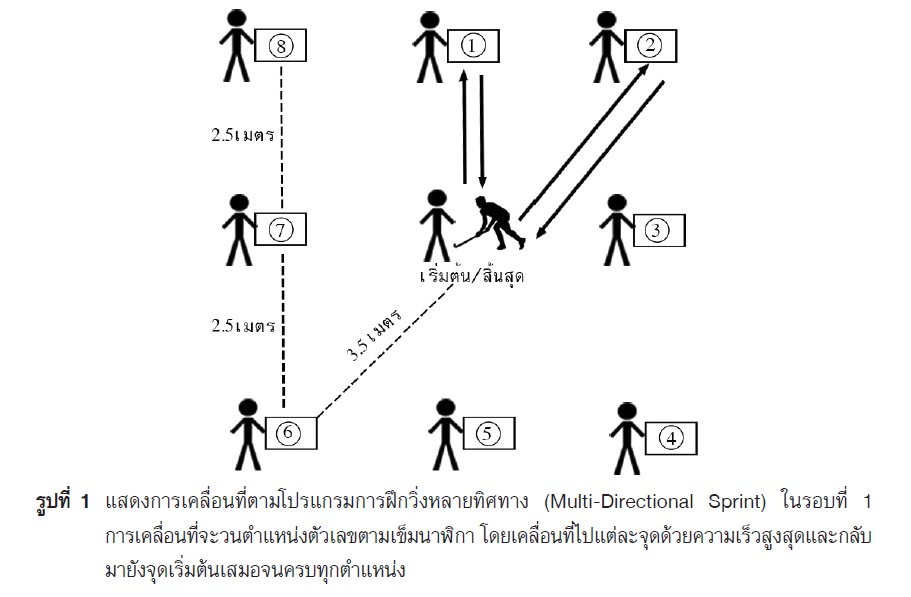EFFECT OF SUPPLEMENTED MULTI-DIRECTIONAL SPRINTS TRAINING ON AGILITY IN ELITE YOUTH FEMALE HOCKEY PLAYERS
Main Article Content
Abstract
Purpose : To determine the effect of supplemented multi-directional sprints training on agility in elite youth female hockey players
Methods : Twenty-four female students from the Chonburi Sports School, aged 17-18 years, were recruited. Players were randomly divided into two groups : a supplemented multi-directional sprints training group (n = 12) and a control group (n = 12). The supplemented multi-directional sprints training group trained 3 rounds/day, 3 days per week over a period of 6 weeks. The general physical characteristics, illinois agility test, pro-agility test, 20 m sprint test and repeated sprint ability (RSA) test were measured before and after training. Dependent variables were analyzed using pair t-test and unpaired t-test. A significance level was accepted at p-value <0.05.
Results : After 6 weeks of traning the mean value of illinois agility test, pro-agility test, 20 m sprint test and repeated sprint ability (RSA) test of the supplemented multi-directional sprints training group were significantly decreased (p<0.05) when compared with pre-test. In control group, the mean values of 20 m sprint test was significantly decreased (p<0.05) compared with prior training. However, there was no significant difference (p>0.05) on illinois agility test, pro-agility test, and repeated sprint ability (RSA) test when compared with pre-test.
Conclusion : The supplemented multidirectional sprints training program had a benefit on agility and change of direction in elite youth female hockey players.
Article Details
References
Bloomfield, J., Polman, R., O’Donoghue, P., & L., M. (2007). Effective speed and agility conditioning methodology for random intermittent dynamic type sports. Journal of Strength and Conditioning Research, 21(4), 1093-1100.
Brughelli, M., Cronin, J., Levin, G. and Chaouachi, A. (2008). Understanding change of direction ability in sport: a review of resistance training studies. International Journal of Sports Medicine, 38(12), 1045-1063.
Dennis, P., B., Christoph, Z., Peter, D., & S., B. (2016). Multi-directional sprint training improves change-of-direction speed and reactive agility in young highly trained soccer players. Journal of Medicine and Science in Sports, 15(2), 314-319.
Espen T., Shaher, A., I, S.,, Thomas H., & E., E. (2011). The effect of 40-m repeated sprint training on maximum sprinting speed, repeated sprint speed endurance, vertical jump, and aerobic capacity in young elite male soccer players. The Journal of Strength and Conditioning Research, 25(9), 2364-2370.
Gabbett, T. J. (2010). Gps analysis of elite women’s field hockey training and competition. The Journal of Strength and Conditioning Research, 24(5), 1321-1324.
Harrison AJ and Bourke G. (2009) The effect of resisted sprint training on speed and strength performance in male rugby players. The Journal of Strength and Conditioning Research, 23(1),275-83.
Koen, A., P., M.,, Lemmink., & Susan, H., V. (2006). Role of energy systems in two intermittent field tests in woman field hockey players. The Journal of Strength and Conditioning Research, 20(3), 682-688.
Lemmink, M. P. A. K., & Visscher, H. S. (2006). Role of energy systems in two intermittent field tests in women field hockey players. The Journal of Strength and Conditioning Research, 20(3), 682-688.
MacLeod, H., Morris, J., Nevill, A., & Sunderland, C. (2008). The validity of a non-differential global positioning system for assessing player movement patterns in field hockey. Journal of Sports Science, 27(2), 121-128.
McCormick, B.T., Hannon, J.C., Newton, M., Shultz, B., Detling, N. and Young, W.B. (2016) The effects of frontal-plane and sagittal-plane plyometrics on change-ofdirection speed and power in adolescent female basketball players. International Journal of Sports Physiology and Performance 11(1), 102-107.
Hill-Haas, S.V., Dawson, B., Impellizzeri, F. M. and Coutts, A. J. (2011). Physiology of small-sided games training in football: a systematic review. Sports Medicine 41(3), 199-220.
Morland, B., Bottoms, L., Sinclair, J., & Bourne, N. (2013). Can change of direction speed and reactive differentiate female hockey players. International Journal of Performance Analysis in Sport, 13(2), 510-521.
Spencer, M., Lawrence, S., Rechichi, C., Bishop, D., Dawson, B., & Goodman, C. (2004). Time–motion analysis of elite field hockey, with special reference to repeatedsprint activity. Journal of sports sciences, 22(9), 843-850.


